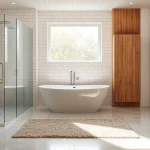Essential Design Principles for Accessible UK Kitchens
Creating a truly wheelchair-friendly kitchen in the UK hinges on applying accessible kitchen design principles that blend functionality with comfort. At the core is ensuring that all key elements—worktops, appliances, storage—are within easy reach, allowing users to operate independently and safely.
Universal design principles guide this process, advocating for spaces that accommodate everyone, including wheelchair users, without the need for adaptation. This means prioritising adjustable-height counters and sinks, clear knee space under work surfaces, and easily operable controls.
This might interest you : Elevate your home with stunning bespoke rooflights
Critical to accessible kitchen design is unobstructed movement. Paths must be wide enough for wheelchair manoeuvrability, typically a minimum of 900mm in width, while turning circles require about 1500mm. These dimensions ensure users can approach appliances or storage without difficulty.
Another essential is layout planning that reduces the need for stretching or twisting. Storage solutions placed at reachable levels, pull-out shelves, and open under-counter spaces help create a wheelchair-friendly kitchen that supports independent daily activities.
This might interest you : Selecting the perfect laundry appliances: a guide for uk families of four
By employing these universal design principles, UK homes can achieve kitchens that are inclusive, practical, and comfortable for all users, making independence and ease of use the highest priorities.
Essential Design Principles for Accessible UK Kitchens
Creating wheelchair-friendly kitchens UK involves more than widening spaces; it’s about embedding accessible kitchen design that encourages autonomy while maintaining comfort. Core principles focus on usability—ensuring that every touchpoint, from cupboards to appliances, is reachable without strain. This means work surfaces and storage must allow forward or side access with clear knee space beneath for wheelchair users.
Applying universal design principles involves crafting kitchens that serve all users without special adaptations. Key to this is incorporating adjustable elements like height-variable worktops and sinks which cater to different user needs. Controls on appliances should be intuitive and operable with minimal force or dexterity, enhancing ease of use for individuals with limited mobility.
Importantly, emphasis on independence means the kitchen should support natural workflows. This reduces physical effort and increases confidence for wheelchair users. For example, incorporating pull-out shelves and lever-style handles aligns with these principles, fostering intuitive interaction with the space.
By prioritising these accessible kitchen design fundamentals, UK homes can seamlessly blend practicality with empowerment, transforming kitchens into genuine hubs of independence for wheelchair users.
Key Layout Adjustments for Wheelchair Accessibility
Smart kitchen layout modifications are crucial for creating truly accessible kitchen layouts UK. The layout must prioritise free movement, enabling wheelchair users to navigate smoothly. Ideal designs include U-shaped or L-shaped configurations with ample turning space of at least 1500mm diameter. Such arrangements prevent unnecessary stretching or repositioning, streamlining daily tasks.
Open-plan kitchens stand out for wheelchair accessibility. Their unobstructed spaces eliminate barriers, allowing users to approach counters and appliances from various angles. Clear pathways of 900mm minimum width ensure easy manoeuvrability while reducing frustration and risk of collisions.
Common mistakes to avoid include narrow corridors, blocked access to essential appliances, and overly tight spaces that restrict turning. Placing appliances and storage too far apart forces excessive movement, undermining independence. Thoughtful positioning of work areas and appliances within reachable distances, aligned with accessible kitchen design principles, supports a seamless workflow.
By focusing on these kitchen layout modifications, UK homes can optimise space for wheelchair users. Integrating open-plan kitchens further enhances usability, making the environment both practical and welcoming. Layout decisions that embrace universal accessibility ensure that kitchens serve everyone with dignity and ease.
Essential Design Principles for Accessible UK Kitchens
Creating wheelchair-friendly kitchens UK demands a focused application of accessible kitchen design principles that centre on autonomy, safety, and comfort. At the heart of these principles is usability—design must enable wheelchair users to approach, reach, and operate all kitchen elements independently. This translates into providing clear knee space beneath work surfaces, allowing forward or side access to countertops, sinks, and appliances without obstruction.
Universal design principles underpin this approach, aiming for adaptability without the need for special modifications. Adjustable-height worktops and sinks are vital, accommodating a wide range of user heights and preferences within the same space. Additionally, controls should be intuitive and require minimal dexterity or strength, enabling ease of use for those with varied mobility challenges.
Independence is further promoted by thoughtful placement of storage and appliances within reachable zones, minimising unnecessary stretching or bending. Lever-style handles and pull-out shelving complement this design ethos by simplifying interactions and reducing physical barriers.
Applying these core ideas ensures that accessible kitchen design in UK homes is more than just compliant—it’s a genuinely empowering environment that embraces universal design principles to support confidence and self-reliance for wheelchair users.
Essential Design Principles for Accessible UK Kitchens
Fundamental to accessible kitchen design is prioritising features that ensure true independence for wheelchair users. This means creating spaces where users can easily access, operate, and move about without assistance, reflecting core universal design principles.
In wheelchair-friendly kitchens UK, key elements include clear knee space beneath worktops and sinks, allowing forward or side access. Adjustable-height counters are invaluable, accommodating varied user heights and sitting positions, which enhances comfort and usability. Appliance controls must be within reach and designed for easy operation with minimal force, catering to users with limited dexterity.
Achieving independence also relies on storage placed within a convenient reach range—neither too low nor too high—and incorporating assistive mechanisms like pull-out shelves or lever handles. These reduce the need for stretching or bending, common barriers to autonomy in the kitchen.
Implementing these accessible kitchen design principles ensures that UK homes do not merely offer physical access but empower wheelchair users with control and confidence. By embedding universal design principles, kitchens become inclusive environments tailored to diverse needs, optimising both functionality and user dignity.
Essential Design Principles for Accessible UK Kitchens
Creating wheelchair-friendly kitchens UK relies heavily on applying accessible kitchen design principles rooted in universal design principles. The core lies in fostering true independence by ensuring that every element—from work surfaces to appliances—is fully reachable and operable by wheelchair users. This means designing with clear knee and toe clearance beneath counters and sinks, allowing both forward and side access without obstruction.
Universal design also requires flexibility. Adjustable-height worktops and sinks accommodate varying user needs, supporting comfort and efficiency. Controls on appliances should be intuitive, positioned within easy reach, and operable without excessive force or fine motor skills, reducing barriers for users with limited dexterity.
Prioritising independence involves thoughtful positioning of storage to avoid stretching or bending. Pull-out shelves and lever-style handles exemplify design choices that enhance accessibility by simplifying interaction with cabinet spaces. The kitchen layout should also promote a natural workflow, making daily activities smoother and less physically demanding.
By embracing these accessible kitchen design essentials alongside universal design principles, UK homes can transform kitchens into empowering spaces that uphold dignity, ease of use, and autonomy for wheelchair users.
Essential Design Principles for Accessible UK Kitchens
Creating wheelchair-friendly kitchens UK requires adherence to core accessible kitchen design principles that prioritise user independence through thoughtful functionality. Central to these principles is ensuring that all surfaces, appliances, and controls are reachable without requiring strain or assistance. Designers apply universal design principles, which mean kitchens are usable by the widest range of people without adaptation, combining flexibility with simplicity.
One foundational approach involves providing ample clear space under countertops for knee and toe clearance. This allows wheelchair users to move close and access work surfaces or sinks comfortably. Another critical aspect is intuitive placement of key elements at reachable heights, avoiding the need to stretch or bend excessively.
Appliance controls and cabinet handles must be operable with limited dexterity and minimal force, enhancing ease of use. Lever-style handles and push-button controls exemplify this principle. Mobility path widths and turning spaces also play a role but are covered extensively in layout design, complementing these principles.
By focusing on these accessible kitchen design essentials in UK homes, designers promote autonomy, safety, and ease. The practical application of universal design principles ensures that wheelchair users can confidently navigate and use their kitchens with dignity and independence.
Essential Design Principles for Accessible UK Kitchens
Accessible kitchen design in wheelchair-friendly kitchens UK fundamentally revolves around universal design principles that prioritise independence and safety. The key is creating a space where wheelchair users can engage fully with the kitchen environment without assistance. This starts with ensuring all frequently used areas are reachable at comfortable heights and with clear access.
Universal design means accommodating varying abilities within the same space, making adaptability a hallmark. This includes providing adjustable height counters and sinks, which allow wheelchair users to work comfortably whether sitting or standing. Additionally, controls on appliances should be within easy reach and operable with minimal force or complex movements, supporting users with limited dexterity.
Independence is further enhanced by logical placement of storage and work areas to avoid unnecessary stretching or bending. Features like pull-out shelves and lever handles foster ease of use, reducing barriers in day-to-day kitchen tasks.
In wheelchair-friendly kitchens UK, embracing these accessible kitchen design fundamentals ensures spaces that empower users through thoughtful, flexible layouts grounded in universal design principles. The result is environments that not only comply with standards but also deliver real autonomy and improved quality of life.
Essential Design Principles for Accessible UK Kitchens
Accessible kitchen design in wheelchair-friendly kitchens UK fundamentally embraces universal design principles that prioritise usability, independence, and safety. Core principles include providing clear knee and toe clearance beneath countertops, enabling wheelchair users to approach work surfaces and appliances comfortably from the front or side. This spatial consideration is key to fostering autonomy.
Universal design in UK homes means creating kitchens that adapt to diverse needs without requiring special modifications. Adjustable-height worktops and sinks exemplify this approach, accommodating users of varying statures and preferred seated positions. Easy-to-use appliance controls with minimal force and dexterity requirements further embody these principles, enhancing accessibility.
Independence is prioritised by intuitive placement of storage and work areas within reachable zones, consciously avoiding excessive stretching or bending. Features such as lever handles and pull-out shelves facilitate effortless interaction with cabinets, reinforcing ease of use. These adaptations consistently adhere to accessible kitchen design fundamentals, ensuring that interest in inclusivity translates into practical, empoweringly functional spaces.
By integrating these core elements, UK homes achieve truly wheelchair-friendly kitchens that uphold dignity and self-reliance for users, demonstrating how universal design principles seamlessly enhance everyday living.









